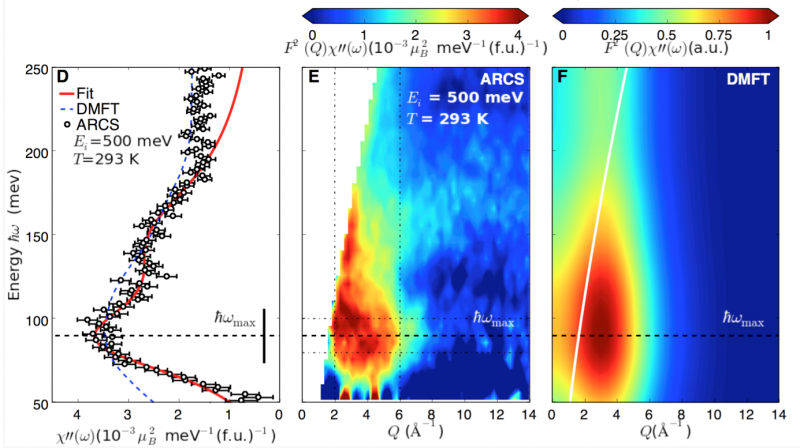Titan helps unpuzzle decades-old plutonium perplexities

First produced in 1940, plutonium is one of the most electronically complicated elements on Earth—and because of its complexities, scientists have been struggling to prove the existence of its magnetic properties ever since.
Finally, that struggle is over, thanks to a timely combination of theory, algorithm and code developments, neutrons experiments, and Titan—the second-most-powerful supercomputer in the world.
The problem had been that conventional band-structure theories gave scientists plenty of hope that magnetic phenomena could be found, but in stark contrast, that hope was always dashed by experiment. Now, via a breakthrough leveraging the US Department of Energy's (DOE's) Oak Ridge Leadership Computing Facility (OLCF) and the Spallation Neutron Source (SNS)—both DOE Office of Science User Facilities—scientists have found the proof they've sought for more than 70 years.
Through an allocation by the DOE Office of Advanced Scientific Computing Research Leadership Computing Challenge, a team of condensed matter theorists at Rutgers University, led by Professors Gabriel Kotliar and Kristjan Haule, used nearly 10 million Titan core hours to calculate the electronic and magnetic structure of plutonium using a combination of density functional theory (DFT) calculations and the leading-edge dynamical mean field theory (DMFT) technique.
"DFT+DMFT is emerging as a powerful electronic structure method for treating strongly correlated materials, and the computations performed on Titan provide the ultimate, definitive answer as to the fate of the magnetism in plutonium," Kotliar said.
Titan revealed that plutonium's magnetism isn't "missing," but, in fact, is just in a constant state of flux, at small but finite energies. This is why it has been next to impossible to detect for so many years. According to Kotliar's calculations on Titan, plutonium's electronic configuration exists, in a sense, between two extremes. Researchers call the peculiarity a quantum mechanical superposition. In this case, electrons are simultaneously both localized and delocalized around the plutonium ion, alternating between magnetic and nonmagnetic states.
Kotliar has been using the DFT+DMFT technique for some time. It's an effective technique for solving many-body problems like plutonium or any microscopic system in which vast numbers of interacting particles are involved. In conjunction with the computationally intensive Monte Carlo method, researchers can sample a small percentage of the electron's interactions, average them, then statistically select the best solution.
"Amazingly," Kotliar said, "DFT+DMFT correctly predicted the energy needed to excite the spin excitations within numerical and experimental errors."
It's a feat, Kotliar says, that could have been done only on a machine as massively parallel as Titan.
ORNL capabilities come together
Kotliar wasn't the only one trying to solve the problem of plutonium's magnetism. While he was at the OLCF crunching numbers on Titan, lead scientist Marc Janoschek of Los Alamos National Laboratory (LANL) was at SNS using neutrons.
With SNS's Angular-Range Chopper Spectrometer, or ARCS, Janoschek and his team performed neutron scattering experiments to obtain physical confirmation to prove once and for all that plutonium's dynamical magnetism wasn't just a theory. In his recent paper published in the journal Science Advances, Janoschek discussed the team's findings.
From the ARCS measurements, the team determined the fluctuations carry varying numbers of electrons in plutonium's outer valence shell. This determination also explained why abnormal changes occur in the differing phases of plutonium's volume.
And remarkably, both the respectively independent neutron experiments at SNS and the theory calculations performed on Titan aligned in near perfect agreement.
"This is a big step forward, not only in terms of experiment but in theory as well. We successfully showed that dynamical mean field theory more or less predicted what we observed," Janoschek said. "It provides a natural explanation for plutonium's complex properties and in particular the large sensitivity of its volume to small changes in temperature or pressure."
"The obtained results not only resolve the long-standing controversy between experiment and theory on plutonium's magnetism but also suggest an improved understanding of the effects of such electronic dichotomy in complex materials," Kotliar said.
Heralded by many fellow scientists in the plutonium community, it's a groundbreaking discovery to be sure.
One of the foremost international authorities on plutonium science, former LANL director Siegfried Hecker, referred to the research as a tour de force.
"Through a great combination of dynamical mean field theory and experiment, neutron spectroscopy, it demonstrates that the magnetic moment in delta-plutonium is dynamic, driven by valence fluctuations, rather than missing," Hecker said. "It also provides the best explanation to date as to why plutonium is so sensitive to all external perturbations—something that I have struggled to understand for 50 years now."
Jack Wells, the OLCF's Director of Science, said, "This scientific breakthrough is a terrific example of what can be achieved through collaborative research between university and national laboratory scientists in the context of DOE's scientific user facilities. Access to large, one-of-a-kind user facilities in the hands of the world's best scientists has led and can continue to lead to transformative results, pointing the way forward to future scientific discoveries."
More information: Janoschek, Marc, et al. "The Valence-Fluctuating Ground State of Plutonium." Science Advances 1, no. 6 (2015): e1500188. DOI: 10.1126/sciadv.1500188.
Shim, J. H., et al. "Fluctuating Valence in a Correlated Solid and the Anomalous Properties of δ-plutonium." Nature 446 (2007): 513–516. doi:10.1038.
Journal information: Science Advances , Nature
Provided by Oak Ridge National Laboratory




















